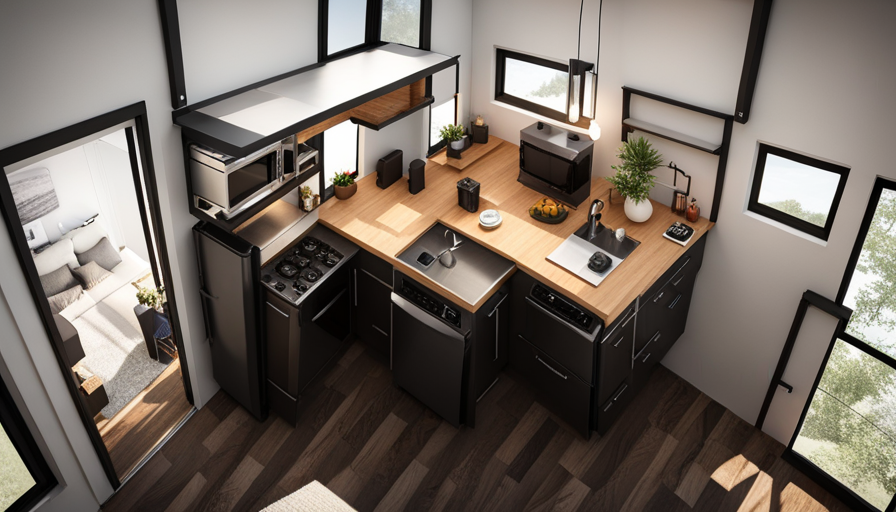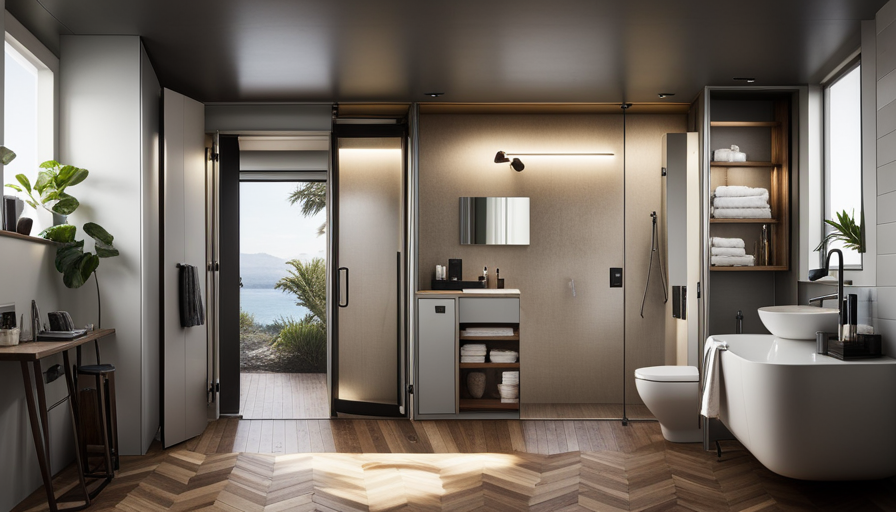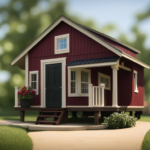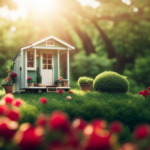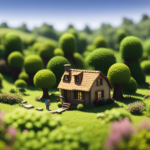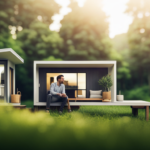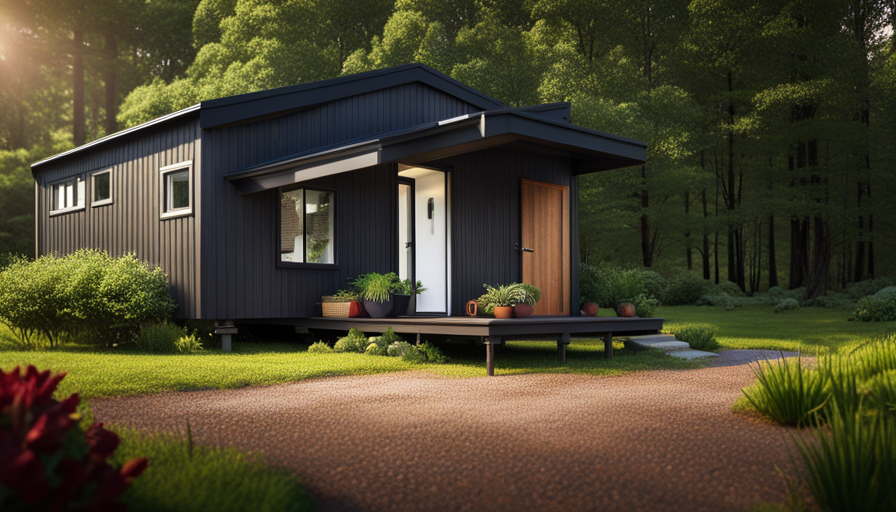Have you ever considered living in a space so small that it could comfortably fit inside a shoebox? Prepare to be amazed, as the S 500 Square Tiny House is even smaller than you realize!
This pint-sized dwelling is a marvel of design and efficiency, packing everything you need into a space that is only 500 square feet. Now, I know what you’re thinking – how is it possible to fit everything into such a tiny space? Well, my friend, that’s where the genius of the S 500 Square Tiny House comes in.
With clever design features and innovative storage solutions, this tiny house manages to create a living space that is not only functional but also surprisingly spacious.
In this article, we’ll explore the exterior dimensions of the S 500 Square Tiny House, as well as its interior layout and design. Get ready to be amazed!
Key Takeaways
- The S 500 Square Tiny House is a compact dwelling measuring 20ft long, 8ft wide, and 9.5ft tall.
- The exterior of the house is made of weather-resistant siding and features a sturdy metal roof.
- The interior layout of the house follows an open floor plan, allowing for seamless flow between the living, dining, and kitchen areas.
- The tiny house utilizes multi-functional spaces with features such as foldable furniture, loft beds with storage, built-in cabinets, sliding walls and doors.
Exterior Dimensions of the S 500 Square Tiny House
The S 500 Square Tiny House may be small in size, but it’s exterior dimensions pack a punch. This tiny house measures 20 feet long, 8 feet wide, and 9.5 feet tall, making it compact yet comfortable.
The exterior materials of the S 500 Square Tiny House are carefully chosen to maximize durability and minimize maintenance. The walls are constructed with high-quality weather-resistant siding, ensuring that the house is well-insulated and protected from the elements. The roof is made of sturdy metal, providing long-lasting protection against rain, snow, and UV rays.
The construction process of the S 500 Square Tiny House involves meticulous attention to detail, ensuring that every inch of space is utilized efficiently.
Now, let’s dive into the interior layout and design, where every nook and cranny is thoughtfully designed for optimal functionality and comfort.
Interior Layout and Design
When it comes to the interior layout and design of the S 500 Square Tiny House, the first thing that stands out is its open floor plan. This allows for a seamless flow between the living, dining, and kitchen areas, creating a spacious and airy feel.
Additionally, the use of multi-functional spaces is a key feature of this tiny house, with cleverly designed furniture and storage solutions that maximize every inch of space.
Lastly, the abundant use of natural light throughout the interior creates a warm and inviting atmosphere, making the S 500 Square Tiny House feel even more spacious and connected to the outdoors.
Open Floor Plan
Imagine yourself stepping into the 500 square tiny house, where the open floor plan unfolds like a blank canvas, inviting you to create your own masterpiece of space and freedom.
The open floor plan of this tiny house is a key element in maximizing the limited square footage. By eliminating unnecessary walls and barriers, the space feels more expansive and airy. It allows for seamless flow between different areas, making it easier to navigate and utilize every inch of the house.
With an open floor plan, you have the flexibility to arrange your furniture and belongings in various configurations, adapting to your changing needs and preferences. The design promotes efficient space optimization, ensuring that every nook and cranny serves a purpose.
As we transition into the next section about ‘multi-functional spaces,’ you’ll see how the open floor plan seamlessly integrates with the concept of versatile living areas.
Multi-Functional Spaces
Get ready to experience the art of versatility as you explore the multi-functional spaces within this innovative and compact living environment. In a 500 square foot tiny house, every inch counts, and that’s why the use of multi-functional furniture and space-saving ideas is essential. Here are four ways that this tiny house maximizes its space:
-
Foldable furniture: From foldable tables to collapsible chairs, every piece of furniture serves multiple purposes and can be easily stored away when not in use.
-
Loft beds with storage: Sleeping quarters are elevated to create additional storage space underneath, allowing for a clutter-free living area.
-
Built-in storage solutions: Custom-built cabinets and shelving are strategically placed throughout the house to make the most of every nook and cranny.
-
Sliding walls and doors: By using sliding walls and doors, the layout of the space can be easily adapted to accommodate various activities.
With these multi-functional spaces, the tiny house becomes a haven of efficiency and practicality.
Now, let’s shed some light on the clever use of natural light.
Use of Natural Light
Step into this innovative living environment and immerse yourself in the clever use of natural light.
The use of natural light in a 500 square foot tiny house has numerous benefits. Not only does it create a warm and inviting atmosphere, but it also helps maximize the limited space available. Natural light has a way of making a small space feel larger and more open.
By strategically placing windows and skylights throughout the house, the sunlight can flood in and illuminate every corner. This not only reduces the need for artificial lighting during the day but also provides a connection to the outside world.
The use of natural light enhances the overall ambiance of the tiny house and creates a sense of tranquility.
As we move into the next section about the living space, we’ll explore how the clever design makes the most of every square inch.
Living Space
The living space in a tiny house is typically small, but it can still be functional and comfortable. The size of the living area will depend on the overall square footage of the house, but it’s important to make the most of the available space.
When it comes to furniture and decor ideas, it’s essential to choose pieces that are multi-functional and can maximize storage. Creating a cozy and comfortable atmosphere can be achieved through the use of warm colors, soft textures, and proper lighting.
Size of the Living Area
Measuring at a mere 500 square feet, the living area of this tiny house is a cozy nook for relaxation and connection. Despite its size, the space is thoughtfully designed to maximize functionality and comfort. The bathroom is compact yet efficient, featuring a space-saving shower and toilet. Additionally, the house boasts an outdoor living space, perfect for enjoying nature and entertaining guests. To give you a better idea of the layout, below is a table showcasing the dimensions of the various areas in the living space:
| Area | Length (ft) | Width (ft) | Total Area (sq ft) |
|---|---|---|---|
| Living Room | 12 | 10 | 120 |
| Kitchen | 8 | 6 | 48 |
| Bathroom | 6 | 4 | 24 |
| Bedroom | 10 | 10 | 100 |
| Outdoor Area | – | – | 208 |
As you can see, every inch of this tiny house has been carefully considered and utilized. With the layout and dimensions in mind, let’s explore some furniture and decor ideas to make this living space truly shine.
Furniture and Decor Ideas
To truly make this living space shine, you’ll want to consider some furniture and decor ideas.
With a 500 square foot tiny house, it’s important to maximize the use of space while still creating a comfortable and inviting atmosphere. When it comes to furniture arrangement, think about multi-purpose pieces that can serve multiple functions. For example, a sofa with built-in storage or a coffee table that can double as a desk. This will help to optimize the limited space available.
In terms of color scheme, consider using light and neutral tones to make the space feel larger and more open. Add pops of color through accent pieces like throw pillows or artwork.
By carefully selecting furniture and decor, you can create a cozy and comfortable atmosphere that maximizes the potential of your tiny house.
Cozy and Comfortable Atmosphere
Create a warm and inviting ambiance in your compact living space by incorporating cozy textures and furnishings that will make you forget about the limited square footage. To achieve a cozy and comfortable atmosphere, focus on two key elements: cozy lighting and comfortable seating. Soft, warm lighting can instantly transform a small space into a cozy haven. Consider using warm-toned lightbulbs and incorporating task lighting in strategic areas to create a comfortable and inviting atmosphere. In terms of seating, choose furniture pieces that are not only comfortable to sit on but also visually appealing. Opt for plush cushions, soft fabrics, and ergonomic designs that maximize comfort without sacrificing style. By combining cozy lighting and comfortable seating, you can create a cozy and comfortable atmosphere that will make your tiny house feel like a home. Transitioning into the subsequent section about the kitchen and dining area, let’s explore how to maximize functionality in a limited space.
Kitchen and Dining Area
Imagine enjoying meals in your cozy kitchen and dining area, perfectly designed to fit within the 500 square feet of your tiny house. The kitchen design maximizes space efficiency, with sleek countertops and clever storage solutions. The layout allows for easy movement and accessibility, ensuring a smooth cooking experience.
In the kitchen, the compact appliances, such as the stove and refrigerator, are strategically placed to optimize functionality. The ample cabinet space provides storage for all your cooking essentials, keeping everything organized and within reach.
The dining area is thoughtfully positioned, providing a comfortable space to savor your meals. A small table and chairs create an intimate setting for meals, fostering a sense of togetherness and warmth. Large windows allow natural light to flood the space, creating an airy and inviting atmosphere.
Transitioning to the subsequent section about bedroom and sleeping arrangements, you’ll find the same attention to detail and thoughtful design throughout the rest of your tiny house.
Bedroom and Sleeping Arrangements
Get ready to experience the coziest and most dreamy sleeping quarters you’ve ever encountered in a compact space. The bedroom layout in this 500 square foot tiny house is carefully designed to maximize comfort and functionality.
Despite its small size, the bedroom offers ample space for a comfortable queen-sized bed, complete with soft linens and fluffy pillows. The clever use of storage solutions ensures that all your belongings have a designated place, keeping the bedroom clutter-free.
Whether you prefer a minimalist aesthetic or a more personalized touch, the bedroom can be easily customized to suit your style. With thoughtful design choices and attention to detail, you’ll find yourself drifting off to sleep in a tranquil and inviting atmosphere.
As we move on to the next section about bathroom facilities, you’ll be delighted to find that the same level of comfort and attention to detail extends throughout the entire tiny house.
Bathroom Facilities
Prepare to be amazed by the luxurious and functional bathroom facilities in this 500 square foot tiny home. Despite its small size, the bathroom layout has been carefully designed to maximize space and provide all the essentials.
The plumbing fixtures are top-of-the-line, including a sleek modern sink, a compact yet efficient toilet, and a spacious shower with a rainfall showerhead.
The bathroom also features clever storage solutions, such as built-in shelves and cabinets, to keep all your toiletries organized and easily accessible.
With the attention to detail and thoughtful design, this bathroom feels anything but cramped.
As we move on to the next section about storage solutions throughout the tiny house, you’ll see how every inch of this space has been utilized to its fullest potential.
Storage Solutions throughout the Tiny House
When it comes to storage solutions in my tiny house, I’ve found that built-in cabinets and shelves are essential. These provide a designated space for all my belongings and help keep everything organized and easily accessible.
Additionally, utilizing vertical space is crucial in maximizing storage in a small area. I’ve installed tall bookshelves and hanging racks to make the most of the vertical space available.
Lastly, I’ve come up with creative storage solutions for various items, such as using under-bed storage bins for extra linens and utilizing the space behind doors for hanging shoe organizers. These strategies have allowed me to make the most of my limited space and keep my tiny house clutter-free.
Built-in Cabinets and Shelves
Step inside the cozy 500 square foot tiny house and admire the cleverly designed built-in cabinets and shelves that maximize storage space. These built-in storage solutions are a game changer for small living. With carefully planned designs, every nook and cranny is utilized to its fullest potential.
The cabinets are strategically placed to make the most of every inch, providing ample space for kitchen supplies, pantry items, and even a hidden space for a washer and dryer. The shelves are adjustable, allowing for customization and accommodating various sizes of items. Additionally, the built-in cabinets feature soft-close doors and drawers, ensuring a quiet and smooth experience.
Within these cabinets, you’ll find designated compartments for different items, making organization a breeze. These thoughtful storage solutions optimize space and eliminate clutter, allowing for a tidy and functional living environment.
Transitioning into utilizing vertical space, the tiny house also maximizes storage opportunities with cleverly placed hooks, hanging racks, and overhead storage options.
Utilizing Vertical Space
One of the most impressive features of this compact living space is how it ingeniously utilizes vertical space, like a puzzle master fitting all the pieces together. Maximizing storage in a tiny house is crucial, and by utilizing vertical space, you can make the most of every inch. With the use of built-in shelves and cabinets that reach all the way up to the ceiling, you can store items that are not frequently used but still need to be accessible. Additionally, you can add hooks, hanging organizers, and wall-mounted storage solutions to keep things off the floor and create a visually appealing display. By thinking creatively and using every nook and cranny, you can find storage solutions for various items without sacrificing space or functionality.
Creative Storage Solutions for Various Items
To maximize storage in your compact living space, get creative with storage solutions for different items. Utilizing vertical space is key in a tiny house, and there are various space-saving techniques that can be used to store a wide range of items.
-
Clothing: Install a hanging rod or use an over-the-door shoe organizer to hang and store clothing items. This allows for easy access and keeps your clothes organized.
-
Kitchenware: Utilize magnetic strips to hang knives and metal utensils on the wall, freeing up valuable drawer space. Install shelves or hooks underneath cabinets to store pots, pans, and mugs.
-
Books and Decor: Utilize wall-mounted shelves or floating shelves to display books and decorative items. This not only adds visual interest to your space but also keeps your items easily accessible.
By implementing these creative storage solutions and space-saving techniques, you can make the most of your tiny house while keeping your belongings organized and easily accessible.
Frequently Asked Questions
What is the maximum weight capacity of the S 500 Square Tiny House?
The maximum weight capacity of the S 500 square tiny house is simply mind-blowing! With its exceptional engineering, this tiny house can support a weight that will make your jaw drop.
And that’s not all, because the customization options are endless. You can personalize your tiny house to perfectly suit your needs and still enjoy the incredible weight capacity. It’s a dream come true for those seeking a compact yet spacious living solution.
Are there any outdoor living spaces or decks included in the design of the S 500 Square Tiny House?
Yes, the S 500 square tiny house offers various design options for outdoor living spaces. The design includes a spacious deck that can be customized to fit your preferences.
This outdoor area provides the perfect space for relaxation, entertaining guests, or enjoying the surrounding nature. The deck adds an extra dimension to the tiny house, expanding the living area and creating a seamless connection between indoor and outdoor spaces.
Can the S 500 Square Tiny House be customized to include additional bedrooms or sleeping spaces?
Yes, the S 500 square tiny house can be customized to include additional bedrooms or sleeping spaces. The customization options allow for space optimization, ensuring that every square inch is utilized efficiently. By adding extra sleeping areas, you can accommodate more people or create separate sleeping quarters for privacy. Whether it’s a loft, bunk beds, or convertible furniture, the customization possibilities are endless, providing flexibility to suit your specific needs and preferences.
What types of appliances are included in the kitchen of the S 500 Square Tiny House?
The appliances in the kitchen of the S 500 square tiny house are carefully selected to maximize functionality within the limited space.
The layout of the kitchen is designed to optimize efficiency and includes essential appliances such as a compact refrigerator, a two-burner cooktop, a combination microwave and convection oven, and a compact dishwasher.
These appliances are strategically placed to ensure easy access and seamless workflow while preparing meals.
Are there any unique storage solutions or features in the S 500 Square Tiny House that are not mentioned in the article?
When it comes to unique storage solutions, the s 500 square tiny house has a treasure trove of surprises. One feature that stands out is the hidden staircase that doubles as a storage unit, providing a clever solution for stowing away belongings.
In addition, there are built-in shelves and drawers tucked away in unexpected places throughout the house, maximizing every inch of space. These features not only create a sense of wonder but also ensure that no space goes unused.
Conclusion
After thoroughly examining the exterior dimensions, interior layout, and various functional spaces of the S 500 Square Tiny House, it’s clear that this compact living solution offers an impressive amount of space for its size.
With carefully designed living areas, a well-equipped kitchen and dining area, comfortable sleeping arrangements, and efficient bathroom facilities, this tiny house truly maximizes its 500 square feet.
Additionally, the abundance of storage solutions throughout ensures that every inch of space is utilized effectively.
The S 500 Square Tiny House is a testament to the ingenuity and versatility of tiny home living.
Hi, I’m Emma. I’m the Editor in Chief of Tiny House 43, a blog all about tiny houses. While tree houses are often associated with childhood, they can be the perfect adult retreat. They offer a cozy space to relax and unwind, surrounded by nature. And since they’re typically built on stilts or raised platforms, they offer stunning views that traditional homes simply can’t match. If you’re looking for a unique and romantic getaway, a tree house tiny house might just be the perfect option.
